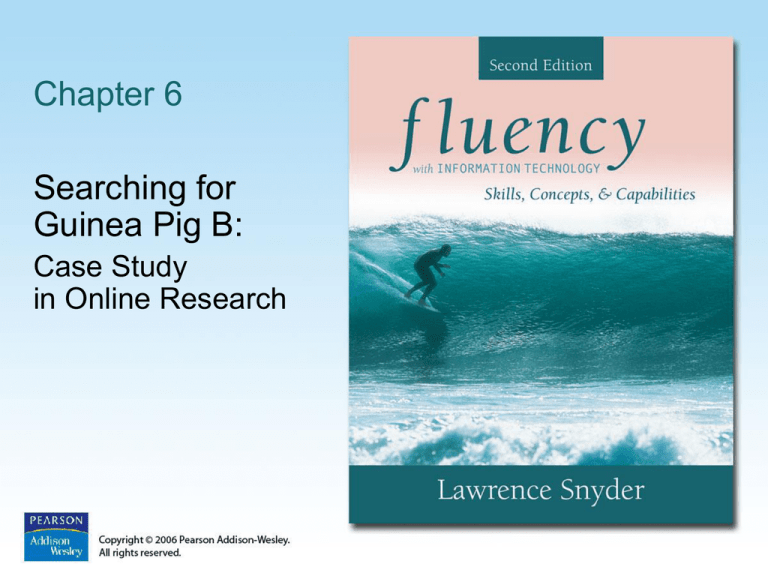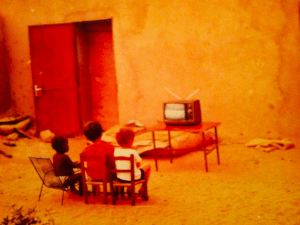
Chapter 6
Searching for
Guinea Pig B:
Case Study
in Online Research
Getting Started with Online Research
• Curiosity-driven research
– Begins with a name or word
– Too little information to begin an informed search with a
search engine
• Searching for information on R. Buckminster Fuller
– Google search on Buckminster AND Fuller
• Returns 92,800 hits
– Limiting to Buckminster AND Fuller AND biography
• Returns 13,900 hits — still too many
– Need to gather identifying information from another source
for a more effective search
Copyright © 2006 Pearson Addison-Wesley. All rights reserved.
6-2
Narrowing the Search
• In this case, an online biography source
– www.biography.com/search/
Copyright © 2006 Pearson Addison-Wesley. All rights reserved.
6-3
Expanding the View
• From Fuller's biography we learn:
– His full name (Richard Buckminster Fuller)
– He is great-nephew of Margaret Fuller
• Who is she? We look her up on biography.com
– That he invented a house and a car that he
named Dymaxion
• New search on Buckminster AND Fuller AND
biography AND Dymaxion
– Returns 543 results
– One biography from IdeaFinder.com lists a different number
of patents, which reminds us that
• Different sources differ
Copyright © 2006 Pearson Addison-Wesley. All rights reserved.
6-4
Searching for Images
• To find out what Fuller looked like:
– Use Google's image search,
www.google.com/advanced_image_search
– Entering Buckminster Fuller returns 2800 .jpg and
.gif images
Copyright © 2006 Pearson Addison-Wesley. All rights reserved.
6-5
Bookmarking Links
• For sites we might want to return to later
• For pictures, it's easier to save a copy rather
than bookmark the URL
• When researching, bookmark every site
visited and record all search keywords in a
file, so you can reconstruct the search
• Bookmarks can always be deleted
Copyright © 2006 Pearson Addison-Wesley. All rights reserved.
6-6
Primary Sources
• Fuller called himself "Guinea Pig B"
• Search for Buckminster AND "Guinea Pig B"
returns 294 results
• First hit is from WNET (New York Public
Television) documentary on Fuller
– Links to essays, one by Fuller's daughter and one
by a collaborator
• These are primary sources — writing from direct
personal experience
Copyright © 2006 Pearson Addison-Wesley. All rights reserved.
6-7
Assessing our Progress
• Secondary sources like Biography.com
provide quick introduction to material
• Primary sources give us most accurate
specific information
– Answers questions short biographies
cannot, like the meaning of Dymaxion
("dynamic, maximum, ion")
Copyright © 2006 Pearson Addison-Wesley. All rights reserved.
6-8
Finding Video Clips
• Video clips of subject are also
primary information
– Fuller describing his ideas in his own words
– Hear the conviction in his voice
– See the emphasis of his gestures
Copyright © 2006 Pearson Addison-Wesley. All rights reserved.
6-9
Chronfile and Everything I Know
• Second result from Google search is a link
to the Buckminster Fuller Institute (BFI)
• Timeline of Fuller's life
• Everything I Know: 42 hours worth
of recordings
– Also transcribed so it can be searched
Copyright © 2006 Pearson Addison-Wesley. All rights reserved.
6-10
Surfing the BFI Site
• Fuller's
Dymaxion Map
– Surface of the
globe projected
onto icosahedron,
which produces
a minimal
distortion flat map
Copyright © 2006 Pearson Addison-Wesley. All rights reserved.
6-11
Resolving Questions
•
•
We know:
–
Fuller invented the geodesic dome
–
Fuller invented the Dymaxion Map
Are they the same idea? If not, how are they
related? How do we find the answer to
these questions?
1.
Determine what kind of information will answer
the question
2.
Look where that type of information may be found
•
In this case, the definitions of the two words may answer
the question
Copyright © 2006 Pearson Addison-Wesley. All rights reserved.
6-12
Resolving Questions (cont'd)
• To define "geodesic" and "icosahedron",
try an online dictionary
Copyright © 2006 Pearson Addison-Wesley. All rights reserved.
6-13
Secondary Sources
• Completing the Picture
– Secondary sources can:
• Give us a more thorough investigation of
the topic and help us fill in gaps
• Help us organize the information
• Provide other authors' interpretations
and insights
– Remember to investigate the sources
for authenticity
Copyright © 2006 Pearson Addison-Wesley. All rights reserved.
6-14
Investigating Controversial Questions
• Controversy regarding discovery
of "tensegrity"
• Fuller's student Ken Snelson feels he was
not given due credit for his part
• Find each party's version of events:
– Snelson's version in an email to International
Journal of Space Structures
– Fuller's version in "Everything I Know"
Copyright © 2006 Pearson Addison-Wesley. All rights reserved.
6-15
Exploring Side Questions
• Our sources have repeated mention of
"buckminsterfullerenes." What are they?
• Google search on the term returns many
useful links
– From Scientific American to SUNY Stony Brook,
to Michigan State University, to online dictionary,
we find the answer:
• A fullerene is a stable molecule of carbon composed of
60 or 70 atoms in the shape of a geodesic sphere
Copyright © 2006 Pearson Addison-Wesley. All rights reserved.
6-16
Case Study Wrap Up
• If we are going to use this information to
write a report, we should create a summary
file containing:
– Bookmarks from the sites visited
– Notebook entries of the search terms used
– Brief notes of our impressions from the information
we found — interesting discoveries, most useful
sites, why we followed up some topics and not
others, etc.
Copyright © 2006 Pearson Addison-Wesley. All rights reserved.
6-17








